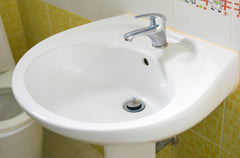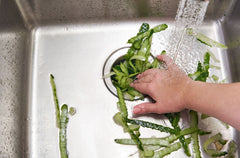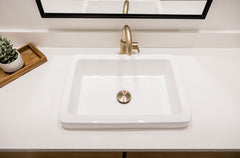Keeping your kitchen sink clog-free is crucial for maintaining a functional and pleasant kitchen environment. A clogged sink can be a major inconvenience, disrupting your daily routines and causing unpleasant odors. Understanding what causes these clogs and how to prevent them can save you time and hassle.
Food scraps and grease are the main culprits behind most kitchen sink clogs. When these substances build up in your drain, they create blockages that prevent water from flowing smoothly. By recognizing these common causes, you can take simple steps to stop clogs before they start.
Daily habits play a significant role in preventing clogs. Using a sink strainer to catch food particles and properly disposing of cooking oils are effective ways to keep your drain clear. In addition, adopting some DIY methods and regular maintenance routines ensures that your kitchen sink remains in good working order. With a little effort and attention, you can enjoy a clog-free kitchen sink and maintain the overall health of your plumbing system.
Common Causes of Kitchen Sink Clogs
Kitchen sink clogs are often caused by food scraps. When washing dishes, tiny bits of food can slip down the drain, especially if you don't scrape plates well before rinsing. Over time, these food particles can accumulate and form a blockage that restricts water flow. Starchy foods like pasta and rice can expand in the pipes, causing even more significant blockages.
Another substantial cause of clogs in the kitchen is grease and oil residues. When you pour grease or oil down the drain, it may be in liquid form, but it cools and hardens in the pipes. This buildup creates sticky layers that trap other debris, such as food particles, leading to a clogged drain. Even small amounts of grease can accumulate over time, eventually causing major blockages.
Kitchen sinks are also prone to soap scum buildup, especially if you use certain dishwashing detergents or soaps. This residue can mix with other debris, creating a thick, sticky substance that clogs your pipes. Regular cleanings and preventive measures can help combat these common causes.
Daily Habits to Prevent Clogs
Using a sink strainer is an effective daily practice to prevent clogs in your kitchen sink. A sink strainer catches food scraps and other debris, stopping them from going down the drain. It's easy to install and maintain, making it a simple yet highly effective solution. All you need to do is empty the strainer regularly to ensure it continues to work well.
Proper disposal of cooking oils is also crucial for preventing clogs. Instead of pouring grease and oil down the drain, collect it in a container and dispose of it in the trash. You can also recycle cooking oils where facilities are available. This practice prevents greasy buildups in your pipes, keeping them clear and free-flowing.
After meal preparation and washing dishes, it's a good habit to rinse the sink thoroughly. Run hot water down the drain to help dissolve and wash away any grease or small food particles that might be lingering. Following these daily habits can significantly reduce the risk of clogs and help maintain a smoothly running kitchen sink.
DIY Methods to Keep Your Drain Clear
One effective DIY method to keep your drain clear is flushing it with boiling water. This simple technique can break down and dissolve any fats, oils, or soap scum that might have started to build up in your pipes. To do this, just boil a pot of water and carefully pour it down your kitchen sink in stages. This helps to ensure the hot water reaches deep into the pipes, melting away any gunk that could lead to clogs.
Another home remedy is using homemade cleaning solutions. A popular and natural method involves baking soda and vinegar. First, pour about half a cup of baking soda down the drain, followed by half a cup of vinegar. The mixture will fizz and bubble, which helps to break down whatever is clogging your drain. After about 15 minutes, flush the drain with hot water to clear away the loosened debris. This method is both effective and environmentally friendly, reducing the need for harsh chemical cleaners.
For more stubborn clogs, you can use a combination of a plunger and hot water. Fill the sink with enough water to cover the plunger's base, and then use the plunger to pump the drain vigorously. This can help dislodge tougher blockages and get your water flowing smoothly again. Regularly using these DIY methods can keep your kitchen sink drain clear and functional.
Long-Term Maintenance Tips
Regular inspection and cleaning are crucial for the long-term maintenance of your kitchen sink drain. Make it a habit to check your sink and drain for any signs of buildup or slow drainage. If you notice water draining more slowly than usual, take immediate action to clean it out before it becomes a bigger problem. Performing regular cleanings, such as flushing with boiling water or using a homemade cleaning solution, can significantly reduce the likelihood of clogs.
Another important aspect of long-term maintenance is knowing what not to put down the drain. Avoid pouring cooking oils, grease, and fats into the sink, as these substances can harden and cause blockages. Also, be mindful of disposing of fibrous or starchy foods, coffee grounds, and eggshells in the trash rather than the drain. These materials can cause significant buildup and lead to clogs over time.
Using a sink strainer consistently can help catch food particles and other debris before they go down the drain. This simple device is easy to clean and can greatly extend the lifespan of your plumbing system by preventing clogs from forming in the first place. By following these long-term maintenance tips, you can keep your kitchen sink drain in optimal condition and avoid unnecessary plumbing issues.
Conclusion
Maintaining a clear and functional kitchen sink drain is essential for smooth kitchen operations. By understanding the common causes of clogs, such as food scraps and grease residues, you can take proactive steps to prevent them. Incorporating daily habits like using a sink strainer and properly disposing of cooking oils makes a huge difference. DIY methods like flushing with boiling water and using natural cleaning solutions help keep your drain clear.
Long-term maintenance, including regular inspection and knowing what not to put down the drain, ensures your plumbing system stays in excellent shape. Utilizing these tips and solutions, you can minimize the risk of clogs and maintain a smoothly operating kitchen sink.
For a more effective way to prevent kitchen sink clogs, visit The Shroom Company to explore our innovative Kitchen SinkShroom, designed to catch debris before it causes blockages.




0 comments